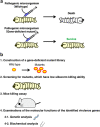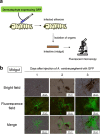Silkworm as an experimental animal for research on fungal infections
- PMID: 30666711
- PMCID: PMC6594098
- DOI: 10.1111/1348-0421.12668
Silkworm as an experimental animal for research on fungal infections
Abstract
Silkworm, Bombyx mori, has various advantages as an experimental animal, such as the low cost for rearing and fewer ethical problems. Models utilizing silkworms of infection with pathogenic bacteria have been established for identification of genes encoding virulence factors by large-scale in vivo screening. In this review, we describe recent progress in the study of silkworm infection models for elucidating the mechanisms of fungi infection. Silkworm infection models have been established for Candida albicans, Candida tropicalis, Candida glabrata and Cryptococcus neoformans, which are yeast type fungi, and Aspergillus fumigatus, Arthroderma vanbreuseghemii, Arthroderma benhamiae, Microsporum canis, Trichophyton rubrum, and Rhizopus oryzae, which are filamentous fungi. Novel genes encoding virulence factors in C. albicans and C. glabrata have been identified by using the silkworm infection models. We here outline the benefits of using silkworm infection models and a strategy for identifying the genes responsible for pathogenicity of microorganisms such as fungi. © 2019 The Authors. Microbiology and Immunology Published by The Societies and John Wiley & Sons Australia, Ltd.
Keywords: human pathogenic fungus; infectious disease; silkworm; virulence factor.
© 2019 The Authors. Microbiology and Immunology Published by The Societies and John Wiley & Sons Australia, Ltd.
Figures



Similar articles
-
Usefulness of silkworm as a model animal for understanding the molecular mechanisms of fungal pathogenicity.Drug Discov Ther. 2015 Aug;9(4):234-7. doi: 10.5582/ddt.2015.01052. Drug Discov Ther. 2015. PMID: 26370522 Review.
-
Usefulness of silkworm as a host animal for understanding pathogenicity of Cryptococcus neoformans.Drug Discov Ther. 2016 Feb;10(1):9-13. doi: 10.5582/ddt.2016.01015. Epub 2016 Feb 19. Drug Discov Ther. 2016. PMID: 26902902 Review.
-
Human fungal pathogens: Why should we learn?J Microbiol. 2016 Mar;54(3):145-8. doi: 10.1007/s12275-016-0647-8. J Microbiol. 2016. PMID: 26920875
-
DNA microarray based on arrayed-primer extension technique for identification of pathogenic fungi responsible for invasive and superficial mycoses.J Clin Microbiol. 2008 Mar;46(3):909-15. doi: 10.1128/JCM.01406-07. Epub 2007 Dec 26. J Clin Microbiol. 2008. PMID: 18160452 Free PMC article.
-
A Silkworm Infection Model for Evaluating In Vivo Biofilm Formation by Pathogenic Fungi.Med Mycol J. 2024;65(1):7-12. doi: 10.3314/mmj.24.001. Med Mycol J. 2024. PMID: 38417885 Review.
Cited by
-
The Response of the Estrogen-Related Receptor to 20-Hydroxyecdysone in Bombyx mori: Insight Into the Function of Estrogen-Related Receptor in Insect 20-Hydroxyecdysone Signaling Pathway.Front Physiol. 2022 Jan 18;12:785637. doi: 10.3389/fphys.2021.785637. eCollection 2021. Front Physiol. 2022. PMID: 35115955 Free PMC article.
-
Development of an efficient gene-targeting system for elucidating infection mechanisms of the fungal pathogen Trichosporon asahii.Sci Rep. 2021 Sep 14;11(1):18270. doi: 10.1038/s41598-021-97287-3. Sci Rep. 2021. PMID: 34521867 Free PMC article.
-
Genome characterization, pathogenicity, and evaluation of therapeutics of Klebsiella aerogenes in Bombyx larvae infection model.BMC Microbiol. 2025 Apr 12;25(1):209. doi: 10.1186/s12866-025-03942-4. BMC Microbiol. 2025. PMID: 40221642 Free PMC article.
-
The silkworm: A promising invertebrate diabetes model for natural drug discovery.Glob Health Med. 2025 Jun 30;7(3):199-210. doi: 10.35772/ghm.2025.01067. Glob Health Med. 2025. PMID: 40606533 Free PMC article. Review.
-
A novel silkworm infection model with fluorescence imaging using transgenic Trichosporon asahii expressing eGFP.Sci Rep. 2020 Jul 3;10(1):10991. doi: 10.1038/s41598-020-67841-6. Sci Rep. 2020. PMID: 32620930 Free PMC article.
References
Publication types
MeSH terms
Substances
LinkOut - more resources
Full Text Sources
Medical

